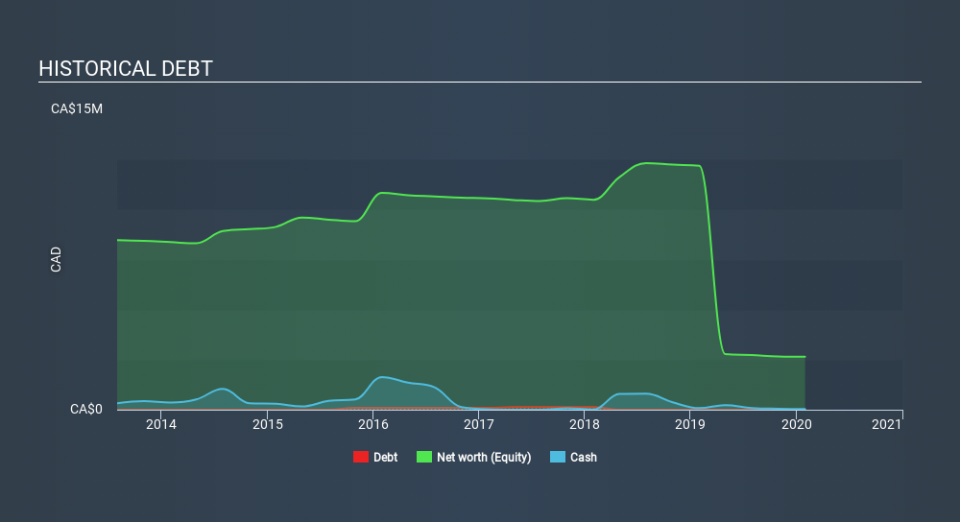Companies Like District Copper (CVE:DCOP) Can Be Considered Quite Risky

Even when a business is losing money, it's possible for shareholders to make money if they buy a good business at the right price. For example, although software-as-a-service business Salesforce.com lost money for years while it grew recurring revenue, if you held shares since 2005, you'd have done very well indeed. Nonetheless, only a fool would ignore the risk that a loss making company burns through its cash too quickly.
So, the natural question for District Copper (CVE:DCOP) shareholders is whether they should be concerned by its rate of cash burn. In this article, we define cash burn as its annual (negative) free cash flow, which is the amount of money a company spends each year to fund its growth. The first step is to compare its cash burn with its cash reserves, to give us its 'cash runway'.
Check out our latest analysis for District Copper
How Long Is District Copper's Cash Runway?
A cash runway is defined as the length of time it would take a company to run out of money if it kept spending at its current rate of cash burn. In January 2020, District Copper had CA$34k in cash, and was debt-free. Importantly, its cash burn was CA$614k over the trailing twelve months. Therefore, from January 2020 it seems to us it had less than two months of cash runway. To be frank we are alarmed by how short that cash runway is! You can see how its cash balance has changed over time in the image below.
How Is District Copper's Cash Burn Changing Over Time?
Because District Copper isn't currently generating revenue, we consider it an early-stage business. Nonetheless, we can still examine its cash burn trajectory as part of our assessment of its cash burn situation. We'd venture that the 63% reduction in cash burn over the last year shows that management are, at least, mindful of its ongoing need for cash. District Copper makes us a little nervous due to its lack of substantial operating revenue. So we'd generally prefer stocks from this list of stocks that have analysts forecasting growth.
How Hard Would It Be For District Copper To Raise More Cash For Growth?
While we're comforted by the recent reduction evident from our analysis of District Copper's cash burn, it is still worth considering how easily the company could raise more funds, if it wanted to accelerate spending to drive growth. Companies can raise capital through either debt or equity. Commonly, a business will sell new shares in itself to raise cash to drive growth. By comparing a company's annual cash burn to its total market capitalisation, we can estimate roughly how many shares it would have to issue in order to run the company for another year (at the same burn rate).
District Copper's cash burn of CA$614k is about 45% of its CA$1.4m market capitalisation. That's high expenditure relative to the value of the entire company, so if it does have to issue shares to fund more growth, that could end up really hurting shareholders returns (through significant dilution).
So, Should We Worry About District Copper's Cash Burn?
As you can probably tell by now, we're rather concerned about District Copper's cash burn. Take, for example, its cash runway, which suggests the company may have difficulty funding itself, in the future. On the other hand at least it could boast rather strong cash burn reduction, which no doubt gives shareholders some comfort. Once we consider the metrics mentioned in this article together, we're left with very little confidence in the company's ability to manage its cash burn, and we think it will probably need more money. On another note, District Copper has 4 warning signs (and 3 which shouldn't be ignored) we think you should know about.
If you would prefer to check out another company with better fundamentals, then do not miss this free list of interesting companies, that have HIGH return on equity and low debt or this list of stocks which are all forecast to grow.
Love or hate this article? Concerned about the content? Get in touch with us directly. Alternatively, email editorial-team@simplywallst.com.
This article by Simply Wall St is general in nature. It does not constitute a recommendation to buy or sell any stock, and does not take account of your objectives, or your financial situation. We aim to bring you long-term focused analysis driven by fundamental data. Note that our analysis may not factor in the latest price-sensitive company announcements or qualitative material. Simply Wall St has no position in any stocks mentioned. Thank you for reading.

 Yahoo Finance
Yahoo Finance 
